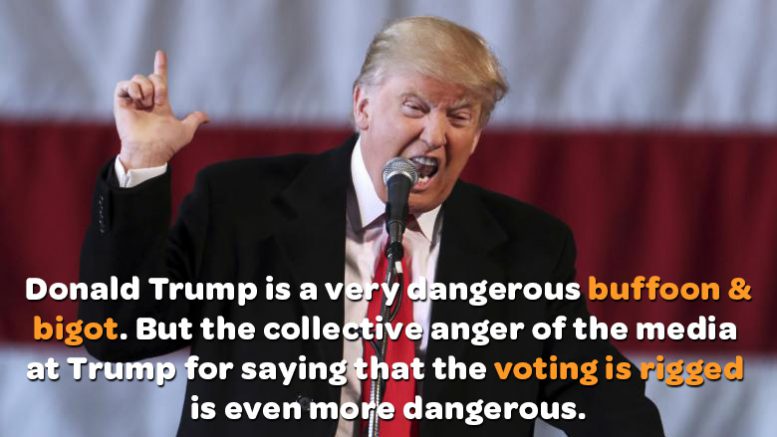By Mark Dunlea
Donald Trump is right that our elections are rigged – though not in the way he describes.
We will never have an accurate vote count on election day as long as we leave the counting (and administration) to the two major parties, who throughout our history have repeatedly stolen votes to benefit those in power. Robert Caro, the Pulitzer-prize winning biographer of President Johnson, wrote about how LBJ got elected to the US Senate after he realized that he had allowed the Republicans to do a better job of vote theft in his first run; he wouldn’t be outstolen a second time, In 2000, the national Republicans felt justified in stealing the election in Florida because they believed that earlier in the Clinton administration that Democrats used their majority control in the House to steal a Congressional election in Connecticut.
Then we have the problems with the new corporate-owned and controlled computer voting systems that repeatedly have produced suspicious vote counts, such as some of the Sanders-Clinton primary results and the 2004 results in Ohio. One point that has been made clear in this election is how easy it is to hack into computer systems. Other democracies have figured out secure and transparent voting systems.
The two major parties rig the elections against third parties and mavericks through restrictive ballot access laws that keep challengers off the ballot. Even if you do get on, the ballot access process can absorb much of a challengers’ funds and resources to navigate. At the presidential level, the two major parties use their control of the Debate Commission to prevent alternative candidates from being heard.
The individual parties also engage in systematic voter suppression. Voter registration laws are used to prevent residents from being able to vote especially if they are tenants, the poor, young, and people of color. The parties often make it difficult to vote on election day, including creating long lines and wait times in low-income communities by restricting the number of voting machines and polling sites. Low-income and communities of color often will have machines they break down more often. The ballots are typically laid out to increase the vote total of the dominant local power.
All these shenanigans are designed to thwart democracy and preserve the power of the status quo (and the 1%).
The world’s other democracies think the American electoral system is an abomination. Yet our politicians, education system and media repeatedly lecture us that we have the best democracy in the world.
The U.S. is one of only three democracies in the world that fails to allocate seats in legislative bodies that reflect the vote total that each party gets in the election. This creates government bodies that reflect that political viewpoints of the population. Instead in the US our winner-take-all electoral system is designed to creates two right of center parties whose policies are shifted even farther to the right through our campaign finance laws which are little more than legalized bribery. Politicians sell themselves to the highest bidders. Most Americans are clueless that in the other world’s democracies the Democrats would be viewed as a far-right party.
The lesser-of-two evils approach to Presidential voting has been dominant in most of my lifetime, at least since 1980. The Democrats have campaigned in each of these elections by describing their opponent as the biggest threat to basic rights in the history of our nation, hold your nose and vote for us to prevent catastrophe. This has reached a new height of absurdity in this year’s election, where every day the media tells Americans that our only choice is between the two most hated political figures in the country.
An easy solution to this problem is ranked choice voting, which would ensure that whoever is elected has majority support. This voting system is on the ballot in Maine this November. Voters would rank candidates in their order of preference, allowing them to vote for which candidate most reflect their viewpoints rather than play defensive games. If no one candidate gets 50% of the vote on the first ballot, the candidate with the least number of voters is eliminated and their voters reallocated to the voter’s second choice until a winner is declared.
Say we had a conservative, moderate and liberal candidate supported respectively by 40%, 35% and 25% of the electorate. 75% of the liberal voters support the moderate as their second choice, and 15% support the conservative and 10% would vote for neither under any circumstance. Under our present voting system, if each person voted for the person they most support, the conservative’s 40% would win – so many liberal voters would be pressured to vote instead for their second choice. Under ranked choice voting, voters would just vote for who they want, and the moderate would win in the second round.
The final rigging of the system is that voters don’t vote for President, we vote for members of an electoral college that then votes for a President. The votes of most individuals in our country are thus irrelevant to the election of the President. This was most notable in the 2000 election where the candidate with the second most number of popular votes won the election. The reality is that our founding fathers rigged our system of government to avoid popular control (e.g., rule by the mob). The electoral college and the U.S. Senate are two of the institutions they used to undercut majority rule.
Donald Trump is a very dangerous buffoon and bigot. But the collective anger of the media at Trump for saying that the voting is rigged is even more dangerous. It would be nice if some of the media engaged in real fact checking.
Hopefully in future elections we will invite in foreign observers to monitor the fairness of our elections.
